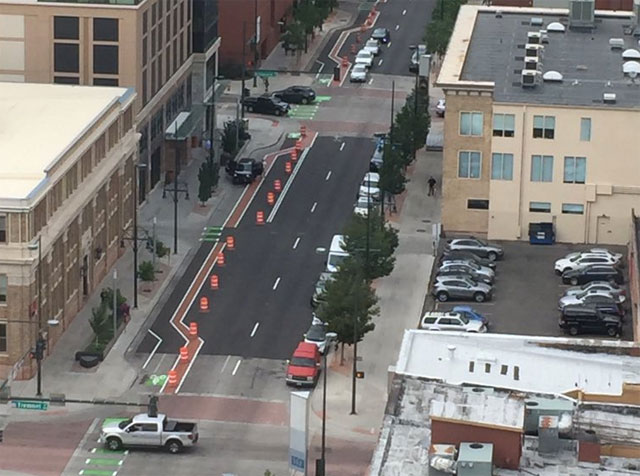Why a Denver Transportation and Mobility Department Should Make Streets Better

When Mayor Michael Hancock announced that Denver would join the ranks of other growing cities like Seattle and Oakland and create a stand-alone transportation department, it may have looked like a mundane bureaucratic matter. But the significance of this change could be profound.
If things work out as envisioned, Denverites will start to see more rapid changes to their streets, and those changes will be bolder than what we’ve come to expect from the Department of Public Works.
Right now, adding a bike lane to Broadway is a multi-year slog, and adding bus lanes to Colfax has been even slower. Putting a dedicated transportation department under its own roof should give the agency chief leading implementation of these projects more clout, via a direct line to the mayor, and streamline planning, operations, and maintenance.
Perhaps most importantly, a Denver DOT should elevate transportation to the first-tier policy priority it should be. The city’s transportation system has deep effects on the economy, housing, and cost of living. There are much more far-reaching decisions to make than how to fix potholes, says Jeffrey Tumlin, who recently oversaw the breakout of Oakland’s DOT from within that city’s public works department.
“If you’re only focusing on the current needs of your current population and not planning for your future populations, when it comes to transport, you’re gonna be in deep trouble,” Tumlin said. “And so that’s one of the reasons why being a strong leader in transport requires significant risk-taking — because you’re always having to anticipate future needs and future changes in order to allow your city and region to thrive.”
Transport directors have to be risk-takers who seize the initiative, he said, whereas public works directors are effective when they “manage by complaint.” Repairing a clogged sewer is an essential government function, but cities have to take on a broader portfolio than upkeep and maintenance if they’re going to build a functional, safe, and efficient transportation system for their residents.
When Tumlin began working in Oakland, he found staff scrambling to appease vocal residents with street fixes. But it turned out that the people who complained most did not represent Oakland’s population as a whole. They were affluent and lived on streets with low crash rates. It wasn’t popular with everyone, including pols looking out for their districts, but Tumlin created a more data-driven protocol. He prioritized safety projects where traffic crashes were claiming the most lives.
Mayor Hancock told Streetsblog that spending via this year’s bond measure and the Denveright planning initiative will go farther if Denver has a separate DOT that’s accountable for implementation.
“We really need to focus,” Hancock said. “We’ve got to elevate our efficacy and effectiveness in implementing strategies. If we’re going to invest the kind of dollars we’re talking about, then we better make sure we’re darn good stewards of it. And by making sure we have a direct line between the mayor and the department, I think we can raise the level of accountability.”
What’s more, advocates for better walking, biking, and transit should be more effective watchdogs with a Denver DOT in place. As the distance shrinks between the mayor and the city’s top transportation policy official, they will have a clearer view of what’s going on, how decisions are made, and where they can use their influence to the greatest effect.
Piep van Heuven has been to countless meetings over the years, both as the head of Bike Denver, and now as the Denver director of Bicycle Colorado. She’s excited about the possibilities that the new DOT will open up.
“We just got closer to the epicenter of where things happen in real time,” van Heuven said. “I think the key is really the connected network, and so the faster the projects roll out, the faster we connect the network, the more we’re gonna reap the dividends and see the change.”


